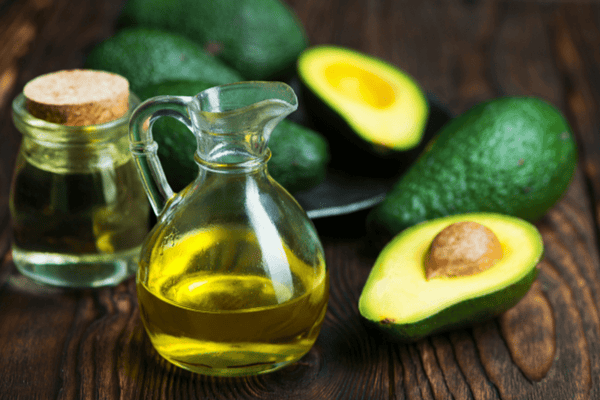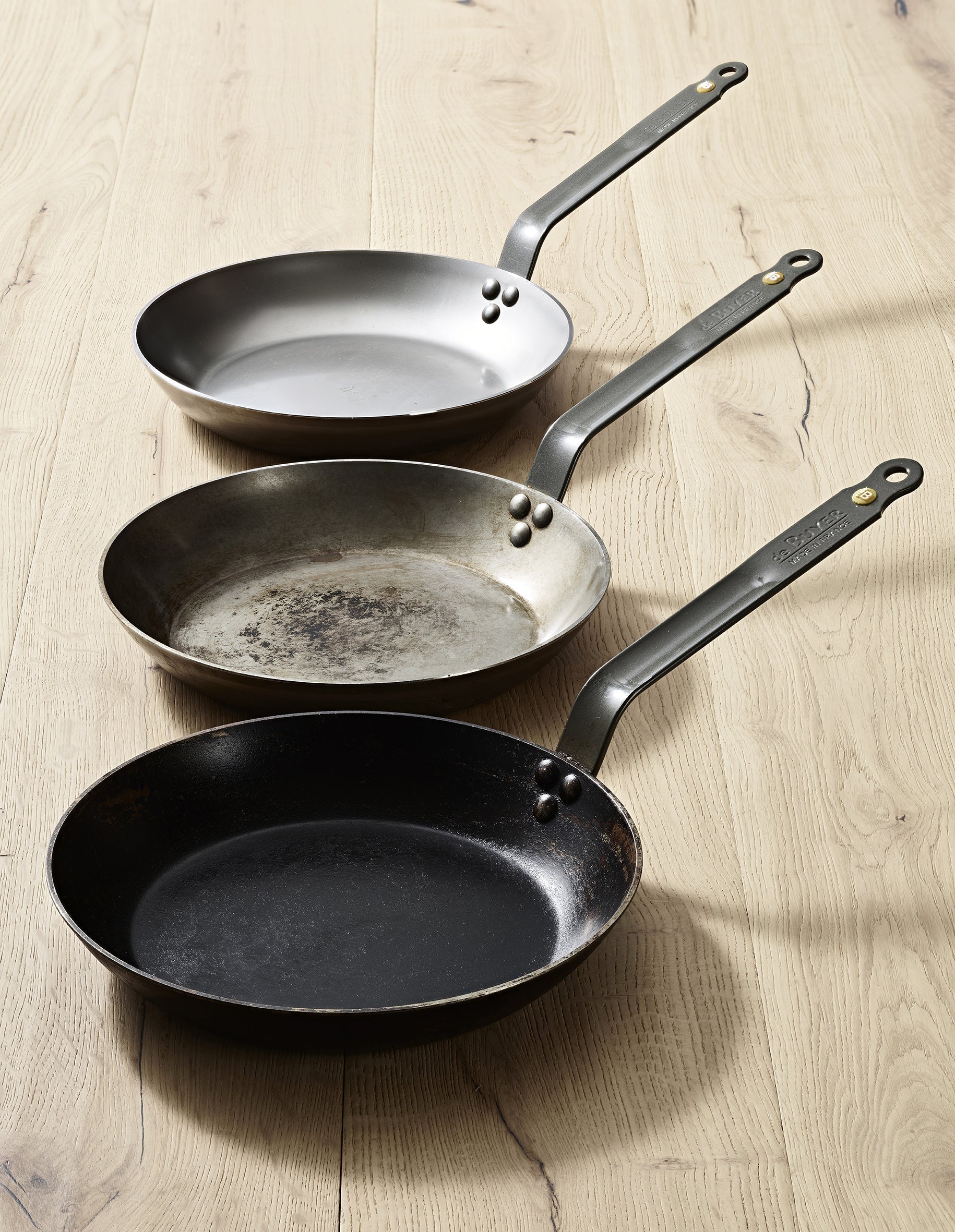HOW TO SEASON A CARBON STEEL PAN
Carbon steel pans have the best of both worlds of a stainless steel pan and a cast-iron skillet. These pans have cast iron's seasoning, natural nonstick properties, and excellent heat retention while utilizing the benefits of stainless steel's heat control. Carbon steel is lighter than cast iron and is an option that only gets better with age. However, the key to getting the most out of your carbon steel pan starts with seasoning. Here's everything you want to know about seasoning carbon steel pans.
Need carbon steel cookware for your kitchen? At de Buyer, we have professional-grade cookware, utensils, and bakeware to help you create the perfect meal. Get your new skillet seasoned and ready to use with these tips!
ACHIEVE THE PERFECT SEASONING
When you get your Mineral B or Mineral B PRO Carbon Steel pan, it is already protected with a layer of beeswax. That French beeswax shields the carbon steel from oxidation and rust before it finds its home in your kitchen. However, you still need to season the pan. Before starting this process, you will want to remove that layer of wax. With that, you will have a fresh base to start the seasoning process for your carbon steel pans. It is ok if a little bit of beeswax is left on the pan since it can help to accelerate the seasoning process. With de Buyer Blue Carbon Steel pans, just rinse with soap and water before seasoning.
Related: Carbon Steel Pan Rust: What to Do About It

WHAT IS SEASONING?
You might be asking yourself, "why is seasoning important?" You need to season the pan if you want to have a nonstick surface that evenly cooks food. And, seasoning will help protect the pan against corrosion and rust. While seasoning might sound like a complicated process, you only need a few ingredients for the job. A thin layer of oil with a high smoke point will help fill in those tiny surface pores, getting your carbon steel pans on the right path to obtaining a good seasoning.
As you continue to cook with the pan, all of the oils and fats from the food will fill in those pores and build up a layer of hardened oil. All of that oil will create a slick patina for your pans. Carbon steel pans have shallow and small pores, meaning you can get a solid layer of seasoning in no time.
You need the initial seasoning of oil and then you will have a pan ready to go. As you cook with the pan, the seasoning will naturally build up and get better over time. After a few uses, that carbon steel pan will have a super slick surface.
If you already have cast iron skillets, you know that it can be a process to achieve a slick surface. Some people have to season the pans three or four times to get a nice cooking surface. That is due to the deep pores of the cast iron, requiring more time to build up the seasoning for a slick surface. You will not have those issues while seasoning your carbon steel.
You will have to watch out for certain foods. Highly acidic ingredients can dissolve the layer of seasoning. Even boiling water might remove your seasoning. But have no fear! You can always re-season the pan for a slick surface.
Related: Everything You Need To Know About Seasoning

YOUR FIRST SEASONING
Now that you know why seasoning is critical, here is how you want to season those carbon steel pans. Think of the new pans as a clean slate. The initial seasoning is a crucial step to set it for future use.
Thankfully, seasoning a carbon steel pan is not as complicated as a cast-iron skillet. If you are not happy with the result, you can always start over and re-season the pan.
There are many ways to season a carbon steel pan. Many people love the stovetop-to-oven method. With this method, you lock in the first round of seasoning to help get those exceptional results.
de Buyer's carbon steel pans have a layer of French beeswax. While this wax is food-safe, you should wash it off the pan. Take hot, soapy water and rub off any residue. Once that is done, you will want to dry the pan. Water will not hurt the seasoning process, but the pan should be dried when placed in the oven. You should dry off the pan with a paper towel, then place it on the stove to evaporate any remaining moisture.

Next, place a foil-lined baking sheet on the bottom rack of the oven. You can preheat the oven, but first, you need to choose the right oil for the job. There are plenty of options to choose from, including soybean, avocado, peanut, and grapeseed oils. You should use a neutral oil of your preference with a high smoke point. No matter what you choose, heat the oven to slightly above the oil's smoke point. Many high-smoke point oils fall in the range of 400 to 450F.
Once the oven is preheated to 475 degrees, take the carbon steel pan and place it on the stove to heat for two minutes. This process opens up the pan's pores and removes any remaining moisture on the surface.
After that, remove the carbon steel from the burner and carefully use a paper towel to apply a thin layer of oil. Rub all of the inside and outside of the pan, making sure it is completely coated. The layer of oil should be thin enough that it will not drip or build up when you tip the pan.
Related: Is Carbon Steel Cookware Safe for Cooking?
Next, you will want to move the hot, oiled pan into the oven. Take the pan and place it upside down on your center rack. If you leave it right-side up, the oil can pool, causing an uneven layer of oil to form. You can leave the pan in the oven for an hour at this stage. Don't panic if you see a little smoke. Once the oil reaches the smoke point, it will smoke in your oven.
When one hour is up, turn off the oven and allow the pan to cool completely.
Some de Buyer pans feature an epoxy coated handle that is only oven safe for short periods of time. For these pans, we recommend a simple stove top seasoning, that is quick and just as effective as oven seasoning. With this method, the first few steps will be the same - once you have a washed and dried pan, lightly coat the insides of the pan with your oil of choice, place it on the stove over medium-high heat, and heat it until the oil starts to smoke. Once you’ve reached the oil’s smoke point, turn off the heat and let the pan cool down before repeating this process.
You are now ready to use your carbon steel pan. If you want to continue to build up the seasoning, just repeat these steps 1-2 more times, then start cooking with it to continue naturally building up the seasoning.
Remember that your carbon steel pan will develop a patina over time. If you notice any discoloration, don't be alarmed. This is part of the process and means it is just on its way to becoming a well-seasoned pan.

SEASONING IS SIMPLE (AND ESSENTIAL)!
These steps can help you achieve the perfect seasoned carbon steel pan. Once you have the initial seasoning, you can continue cooking with these pans to achieve the best results for your meals.
Looking for your next piece of cookware? At de Buyer, all of our carbon steel pans are ready to season to your specifications. Choose the next perfect pan for your kitchen!
